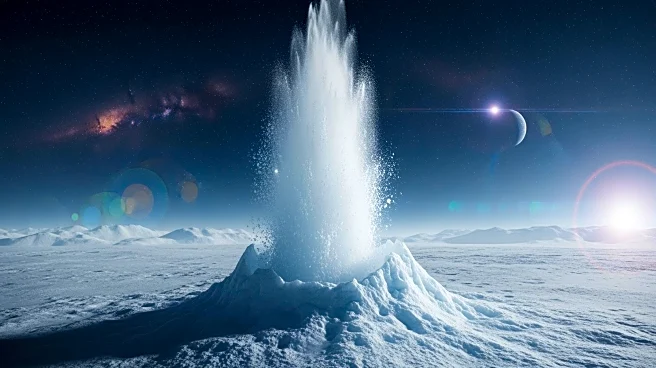What's Happening?
A new study led by researchers from Oxford University, Southwest Research Institute, and the Planetary Science Institute has revealed significant heat flow at Enceladus's north pole, challenging previous
assumptions that heat loss was confined to its active south pole. This discovery suggests that Enceladus, one of Saturn's moons, is emitting more heat than expected, which strengthens the possibility that it could support life. The study, published in Science Advances, indicates that Enceladus has a global, salty subsurface ocean, which is believed to be the source of its heat. The presence of liquid water, heat, and essential chemicals like phosphorus and complex hydrocarbons make Enceladus a prime candidate for life beyond Earth. The balance of energy loss and gain, maintained by tidal heating from Saturn's gravity, is crucial for sustaining this environment.
Why It's Important?
The findings are significant as they enhance the understanding of Enceladus's potential to support life. The moon's ability to maintain a stable environment with balanced energy dynamics is essential for life to evolve. This research provides insights into the long-term sustainability of Enceladus's subsurface ocean, which could be one of the best places in the solar system for life to exist outside Earth. The study also highlights the importance of thermal data in estimating ice shell thickness, which is vital for future missions aiming to explore Enceladus's ocean. The discovery of heat flow at the north pole expands the understanding of Enceladus's geological activity, which was previously thought to be limited to the south pole.
What's Next?
The next steps involve determining the age of Enceladus's ocean to assess whether it has existed long enough for life to develop. Future missions may focus on probing the moon's ocean using robotic landers or submersibles. The study emphasizes the need for long-term missions to ocean worlds that may harbor life, as data obtained might reveal crucial information decades later. Understanding the ice shell thickness and the dynamics of Enceladus's heat flow will be critical for planning these missions.
Beyond the Headlines
The discovery of heat flow at Enceladus's north pole not only challenges previous geological assumptions but also opens up new possibilities for understanding the moon's potential to support life. The study underscores the importance of long-term scientific missions and the role of advanced technology in uncovering the secrets of distant celestial bodies. The implications of this research extend beyond Enceladus, as it contributes to the broader search for life in the universe.











